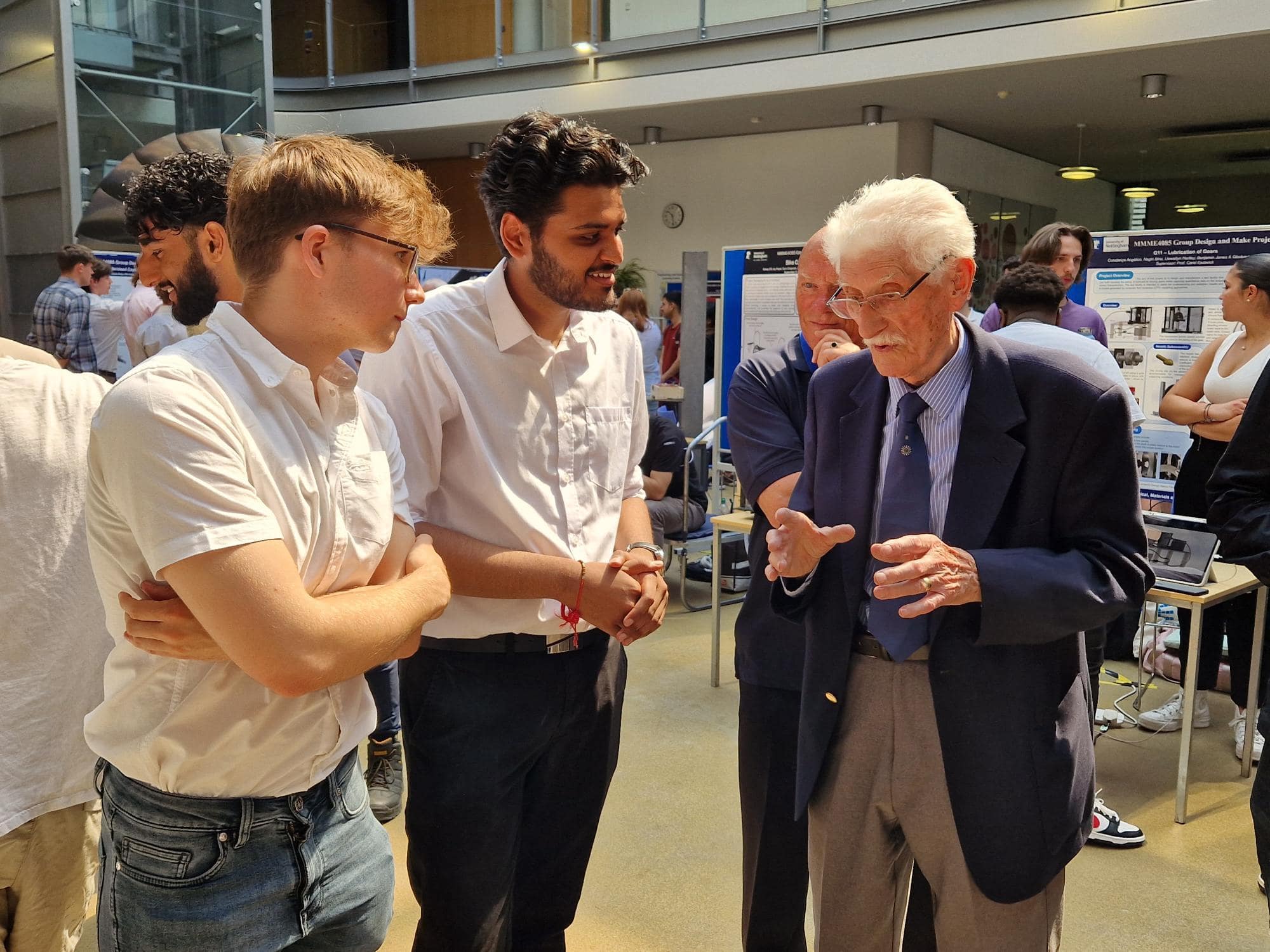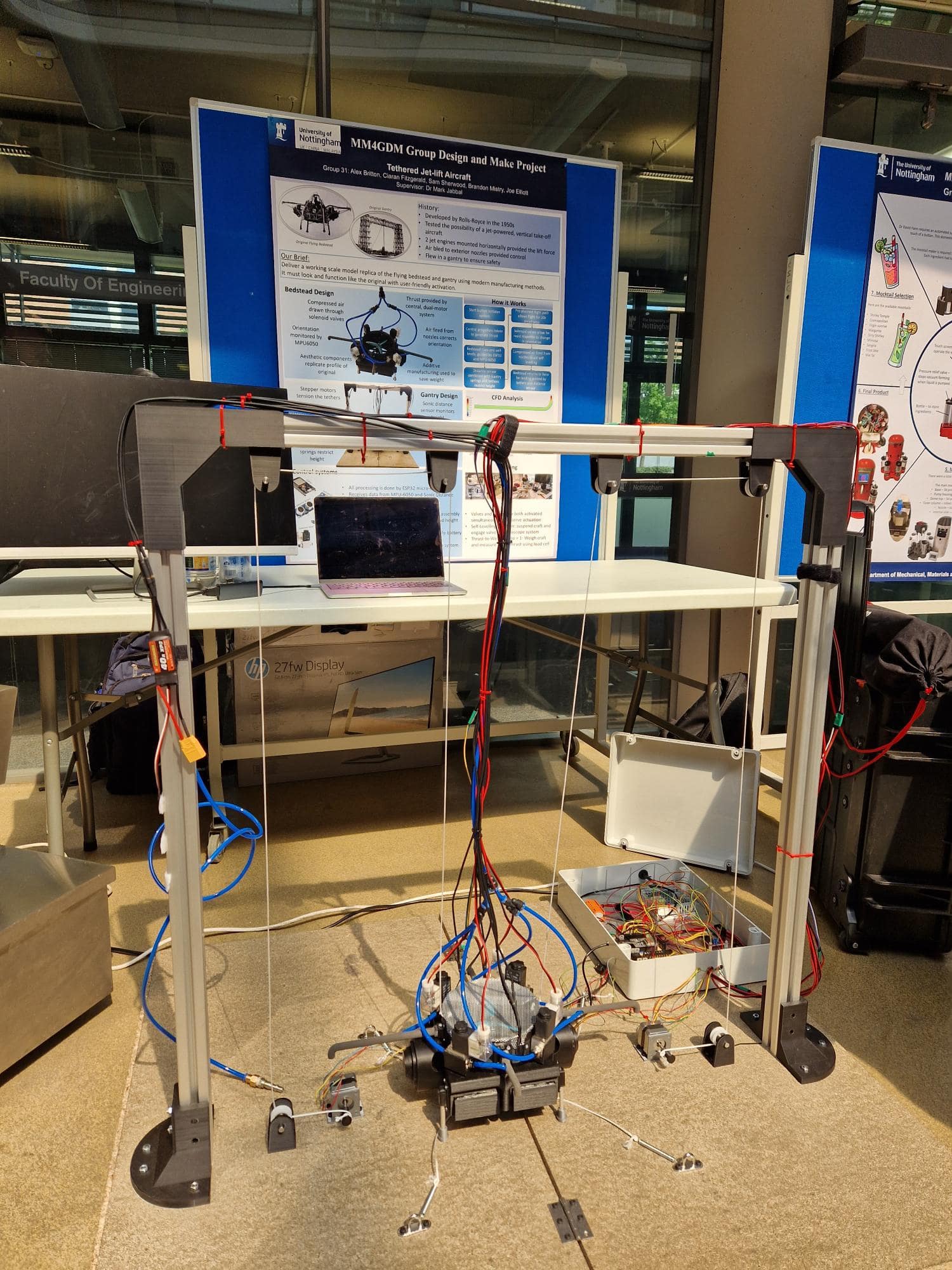Tuesday, 04 July 2023
A working scaled replica of the Rolls-Royce Thrust Measuring Rig (TMR), better known as the “Flying Bedstead” has been built by engineering students at the University of Nottingham.
Built and tested by Rolls-Royce in Hucknall, the TMR was the first jet-lift aircraft to fly anywhere in the world, with its inaugural tethered flight taking place in 1953, followed by its first free flight the following year.
Now, to celebrate what would have been the original developer Alan Arnold Griffith’s 130th birthday, as well as the 70th anniversary of its first tethered flight, Engineering students have spent their third year building a representative copy of the experimental aircraft, using modern methods such as 3D printing and open-source electronics, which was unveiled at an exhibition this week.
Associate Professor Mark Jabbal, Aerospace Engineering Programme Director at the University of Nottingham, said: “Currently, there’s only one TMR on static display in the world, at the London Science Museum, so having our students build this working scaled replica means that more people around the country will be able to get a glimpse of this fascinating piece of aviation."
Not many people are aware that Nottinghamshire is the birthplace of vertical jet lift technology, so this project has not only provided students with practical knowledge, but it’s also given them a greater understanding of our heritage and the part we played in aviation history.
The replica was unveiled, alongside 30 other student projects, with several special guests in attendance, including AA Griffith’s son, John, and grandson, Harvey, as well as Les Fenwick, a former Rolls-Royce TMR Engineer who worked on the original “Flying Bedstead” in the 1950s.

As soon as I saw the replica, I was taken back to when I was an apprentice more than 50 years ago and I thought: ‘That’s it’. The students have done a truly marvellous job and it’s made me feel a little bit emotional that my colleagues who are no longer with us aren’t able to see this fantastic recreation of the TMR we all worked tirelessly on. This time 50 years ago, we were responsible for a world first, and now, the students have done the same.
John Griffith said: “It’s a great honour and privilege for me to talk to the students about their work and see the TMR. This replica is keeping my father’s idea and memory alive, so seeing it on what would have been his 130th birthday makes it even more poignant. Sadly, he passed away 60 years ago but I think he would have been very intrigued and impressed by what the students have created if he were here today – while still making sure to take a very critical look at the inner workings, of course!”
Joseph Elliott, a Mechanical Engineering student who was part of the group to recreate the TMR, said: “Recreating the TMR in a compact form using modern manufacturing techniques proved to be a very challenging and ambitious project. Each member of our team contributed a huge amount, and we are all very proud of the outcome.
 The TMR replica
The TMR replica
“Some of the main issues we encountered were the design of the pneumatics system, which allows the device to stabilise itself using compressed air and the electronics/control system. Also, development of the gantry safety system, which protects both the device and viewers, required much consideration. We are grateful to have had the opportunity to replicate this piece of history and very thankful to those who came to see it unveiled.”
Now the model is complete, it will be kept at the university until it can go on display at the Rolls-Royce Heritage Centre and the Hucknall Flight Test Museum, where the original TMR was built and tested 70 years ago, when it reopens in August.
Mark added: “It’s a testament to the hard work of the students – Joseph, Alex, Brandon, Ciaran, and Sam - that the replica will eventually be exhibited at the Hucknall Flight Test Museum, and I’ve been very impressed at how they’ve managed to stay true to the original designs while incorporating modern techniques into the process.”
To find out more about the university’s Mechanical Engineering course, please click here.
Story credits
More information is available from Mark Jabbal, in the Faculty of Engineering at the University of Nottingham at mark.jabbal@nottingham.ac.uk or; Danielle Hall, Media Relations Manager for the Faculty of Engineering at the University of Nottingham, at danielle.hall@nottingham.ac.uk
About the Faculty of Engineering
Made up of six departments – Architecture and Built Environment, Chemical and Environmental Engineering, Civil Engineering, Electrical and Electronic Engineering, Mechanical, Materials and Manufacturing Engineering and Foundation Engineering and Physical Sciences – the university’s Faculty of Engineering is home to more than 5,600 students and 800 staff.
The faculty, which has educated engineers and architects for more than 140 years, was the first in the country to be accredited with an Athena SWAN Gold Award for excellence in advancing gender equality across higher education and research and is home to multiple state-of-the-art facilities, including the recently opened £40m Power Electronics and Machines Centre (PEMC).
With research at its heart, 21 research groups are undertaking pioneering projects for a sustainable future across several themes – including net zero transport, sustainable energies and the built environment, advanced manufacturing, and healthcare technologies – and has delivered a positive impact in more than 20 countries. Within those countries, the faculty’s research has supported 500 companies and three governments – that have changed their strategies as a result of its research – and has also directly created jobs for around 3,000 people across the world.
Notes to editors:
About the University of Nottingham
Ranked 97 in the world and 17th in the UK by the QS World University Rankings, the University of Nottingham is a founding member of Russell Group of research-intensive universities. Studying at the University of Nottingham is a life-changing experience, and we pride ourselves on unlocking the potential of our students. We have a pioneering spirit, expressed in the vision of our founder Sir Jesse Boot, which has seen us lead the way in establishing campuses in China and Malaysia - part of a globally connected network of education, research and industrial engagement.
Nottingham was crowned Sports University of the Year by The Times and Sunday Times Good University Guide 2024 – the third time it has been given the honour since 2018 – and by the Daily Mail University Guide 2024.
The university is among the best universities in the UK for the strength of our research, positioned seventh for research power in the UK according to REF 2021. The birthplace of discoveries such as MRI and ibuprofen, our innovations transform lives and tackle global problems such as sustainable food supplies, ending modern slavery, developing greener transport, and reducing reliance on fossil fuels.
The university is a major employer and industry partner - locally and globally - and our graduates are the third most targeted by the UK's top employers, according to The Graduate Market in 2024 report by High Fliers Research.
We lead the Universities for Nottingham initiative, in partnership with Nottingham Trent University, a pioneering collaboration between the city’s two world-class institutions to improve levels of prosperity, opportunity, sustainability, health and wellbeing for residents in the city and region we are proud to call home.
More news…